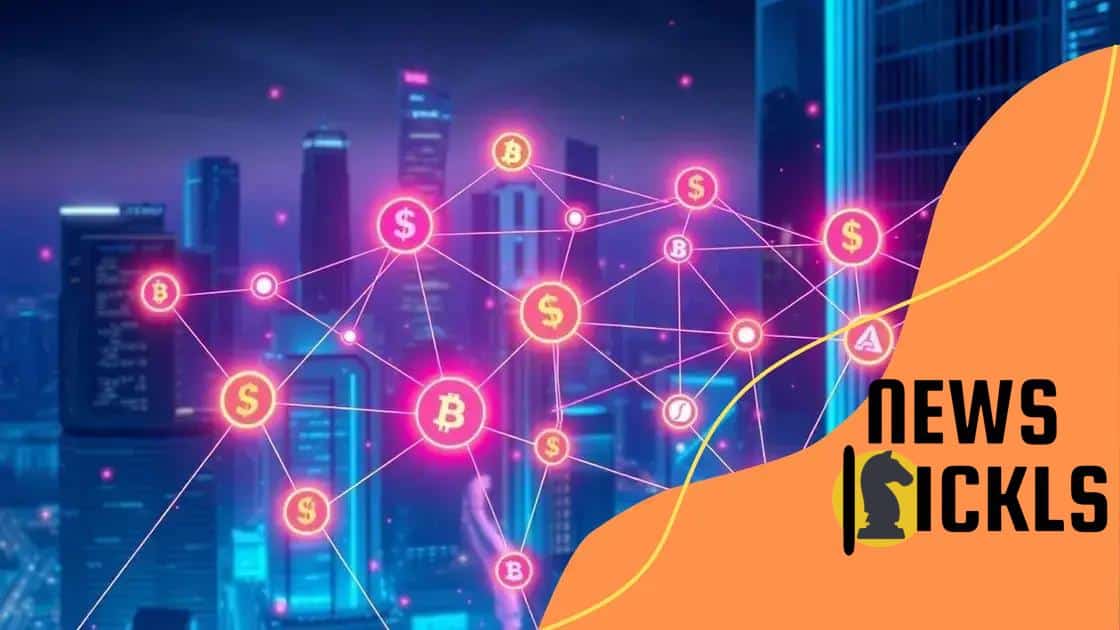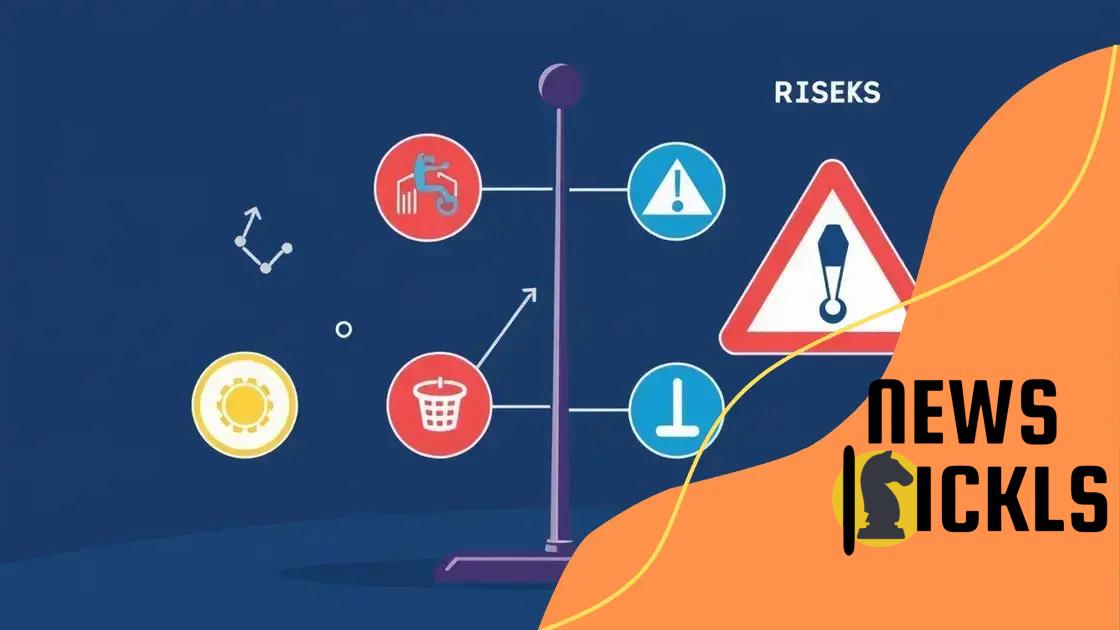The rise of decentralized finance and its impact on markets

The rise of decentralized finance (DeFi) presents a transformative shift in financial services, enabling users to lend, borrow, and trade without intermediaries, while offering accessibility and flexibility but also introducing risks like market volatility and regulatory uncertainties.
The rise of decentralized finance is transforming the way we think about money and investment. Have you ever wondered how this emerging trend might impact your financial future? Let’s dive into what DeFi means for you.
Understanding decentralized finance (DeFi)
Understanding decentralized finance (DeFi) represents a shift in the way we perceive financial systems. Traditional finance is often centralized, relying on banks and intermediaries. In contrast, DeFi uses blockchain technology to create financial systems that operate without these intermediaries.
This transformation empowers individuals, allowing for greater control over their finances. Users can access lending, borrowing, and trading directly through decentralized applications (dApps). Let’s explore some key components of this evolving landscape.
Key Components of DeFi
Several elements make up the DeFi ecosystem. These include:
- Smart Contracts: Automated contracts that execute transactions when conditions are met.
- Decentralized Exchanges (DEXs): Platforms for trading cryptocurrencies without a central authority.
- Liquidity Pools: Funds provided by users to facilitate trading on DEXs, earning them rewards.
- Stablecoins: Cryptocurrencies designed to maintain a stable value, often pegged to fiat currency.
By utilizing these components, DeFi offers benefits like increased accessibility and lower fees. However, it is essential to be aware of the risks involved, such as security vulnerabilities and market volatility.
As we continue exploring this topic, you will see how decentralized finance not only enhances financial systems but also introduces a new paradigm for managing assets. Understanding its implications will be crucial as we move forward.
Key components of the DeFi ecosystem
Understanding the key components of the DeFi ecosystem is essential for grasping its significance. Each element plays a vital role in creating a decentralized financial system that is accessible and efficient.
Smart Contracts
Smart contracts are self-executing contracts with the terms directly written into code. They automate transactions and processes, eliminating the need for intermediaries. This not only speeds up transactions but also reduces costs significantly.
Decentralized Exchanges (DEXs)
Another crucial element is decentralized exchanges, or DEXs. Unlike traditional exchanges, DEXs operate without a central authority, allowing users to trade cryptocurrencies directly with one another. This adds a layer of security and transparency to trading activities.
- Users have full control over their funds.
- Trading occurs directly between users’ wallets.
- DEXs typically charge lower fees than centralized exchanges.
- Liquidity pools provide the necessary funding for trades.
Additionally, liquidity pools enable users to pool their funds to facilitate trading. By providing liquidity, these users earn a share of the transaction fees. This incentivizes participation and enhances the overall functionality of the DeFi ecosystem.
Stablecoins
Last but not least, stablecoins play a fundamental role. They are digital currencies designed to maintain a stable value, often pegged to a fiat currency like the dollar. This stability makes them useful for transactions within the DeFi world, mitigating the volatility commonly seen in cryptocurrencies.
By exploring these key components, it’s clear how they work together to create a cohesive and innovative financial system, enabling users to engage in various financial activities without traditional barriers.
Advantages and risks of DeFi

Exploring the advantages and risks of DeFi is crucial for anyone interested in this innovative sector. DeFi offers numerous benefits that can transform how we engage with finance, while also presenting challenges that warrant careful consideration.
Advantages of DeFi
One of the primary advantages of decentralized finance is accessibility. Unlike traditional financial systems, DeFi is open to anyone with an internet connection.
- Lower Fees: DeFi eliminates intermediaries, reducing transaction costs.
- 24/7 Availability: DeFi services operate around the clock, allowing users to access their funds anytime.
- Greater Control: Users retain full ownership of their assets without relying on third parties.
- Global Reach: Offers financial services to individuals in underserved regions.
These advantages make DeFi a compelling alternative to traditional finance. Users can engage in lending, borrowing, and trading easily. The potential for high returns on investments also attracts many to this space.
Risks of DeFi
While DeFi has many benefits, it’s important to consider the risks associated with it. The decentralized nature can lead to vulnerabilities that users should be aware of.
- Market Volatility: Cryptocurrencies can experience rapid price fluctuations, which can impact investments.
- Smart Contract Bugs: Errors in coding can lead to the loss of assets.
- Regulatory Uncertainty: Changes in laws could affect the operation of DeFi platforms.
- Liquidity Risks: Some assets may become illiquid, making it hard to sell.
Understanding these risks is crucial for effective participation in DeFi. Participants need to conduct thorough research and remain vigilant. Balancing the rewards with an awareness of the potential pitfalls will enhance the DeFi experience.
Real-world applications of DeFi
The real-world applications of DeFi are expanding rapidly, showcasing how decentralized finance is changing various sectors. From lending to asset management, DeFi is making finance more accessible and efficient.
Lending and Borrowing
A primary application of DeFi is in lending and borrowing platforms. Users can lend their cryptocurrencies and earn interest. Similarly, borrowers can access funds without needing traditional credit checks. This opens up financial services to those who might be overlooked by banks.
- Peer-to-peer Lending: Users can lend directly to others on platforms.
- Flexible Terms: Borrowers can negotiate their own terms.
- Instant Transactions: Funds are available almost immediately.
Such flexibility allows for innovative financial solutions that cater to diverse needs.
Decentralized Trading
Another significant application is decentralized trading on platforms known as DEXs (Decentralized Exchanges). Here, users can trade cryptocurrencies without relying on a centralized authority. This reduces risks related to hacks and fraud.
- Increased Privacy: Users retain control of their data.
- Lower Fees: DEXs often have minimal trading costs.
- Global Accessibility: Anyone with internet access can participate.
These factors contribute to the growing popularity of decentralized trading platforms.
Yield Farming and Staking
Yield farming and staking are common practices in the DeFi space. Users lock their assets in a platform to earn additional tokens or interest. This incentivizes holding assets long-term while simultaneously providing liquidity to the ecosystem.
By diversifying into real-world applications, DeFi demonstrates tangible benefits for individuals and businesses alike. As adoption increases, we can expect to see even more innovative uses emerge.
Future trends in decentralized finance
The future trends in decentralized finance show that this sector is evolving at a rapid pace. As more users embrace DeFi, we can expect to see a variety of innovations that reshape the landscape.
Integration with Traditional Finance
One significant trend is the increasing integration of DeFi with traditional finance. This collaboration allows for smoother transitions between conventional banking systems and decentralized platforms. As banks become more open to this idea, users may have better access to financial services.
- Partnerships: More partnerships between DeFi projects and banks are likely to emerge.
- Financial Products: Hybrid products combining both worlds could be developed.
- Improved Security: Banks may introduce robust security measures for DeFi applications.
Such developments could help build trust among new users.
Interoperability Solutions
Another promising trend is the push for interoperability solutions. As various DeFi platforms proliferate, the need for them to communicate effectively grows. Interoperability allows users to move assets freely across different platforms.
- Cross-chain Protocols: These will enable transactions across multiple blockchains.
- Asset Swaps: Instant swaps of assets between different DeFi applications will become easier.
- Unified User Experience: A seamless experience across platforms will enhance user engagement.
Creating a more connected ecosystem benefits everyone involved.
Regulatory Developments
As DeFi continues to gain popularity, regulatory developments will play a significant role in shaping its future. Governments and regulatory bodies are beginning to take notice. Striking a balance between innovation and regulation will be essential for healthy growth.
Some potential outcomes include clearer guidelines for DeFi projects and increased compliance. This can lead to higher consumer protection and bolster the legitimacy of the entire sector.
With these trends in mind, the trajectory of decentralized finance appears bright. As integration with traditional finance, interoperability, and regulatory clarity improve, DeFi will likely expand its reach and influence.
In conclusion, the world of decentralized finance is rapidly evolving, offering both exciting opportunities and significant challenges. As DeFi continues to grow, key trends indicate a future where integration with traditional finance, interoperability, and regulatory clarity will shape its landscape. With these advancements, more individuals will gain access to financial services, and DeFi’s potential will be unlocked further. Understanding these dynamics is vital for anyone looking to participate in this innovative sector.
FAQ – Frequently Asked Questions about Decentralized Finance (DeFi)
What is decentralized finance (DeFi)?
DeFi refers to a financial ecosystem that operates without centralized intermediaries, using blockchain technology to enable services like lending, trading, and earning interest.
What are the advantages of using DeFi platforms?
Advantages include lower transaction fees, greater control over your assets, 24/7 access to services, and the ability to earn interest on your cryptocurrencies.
What risks should I be aware of in DeFi?
Risks in DeFi include market volatility, potential smart contract bugs, and regulatory uncertainties that could impact the operation of DeFi platforms.
How can I get started with DeFi?
You can start by creating a cryptocurrency wallet, choosing a DeFi platform that suits your needs, and exploring services like lending or trading. Make sure to do thorough research first.






